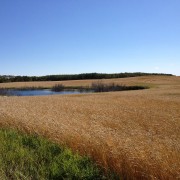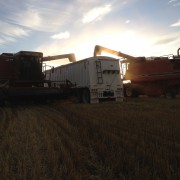The RISK 2-Step
Here is a quote I recently read that was attributed to John D. Ingalls in Human Energy:
“The degree to which ambiguity can be tolerated determines the amount of difficulty
the individual can, and is willing to, meet and overcome in coping with the problems of
human life and in taking advantage of the opportunities life has to offer.”
Let’s make a few changes and see how it applies to business:
The degree to which risk can be tolerated determines the amount of variability the
business owner can, and is willing to, accept and manage in coping with the cycles of
business and in taking advantage of the growth opportunities that risk presents.
A good fair portion of any given week has me speaking with some very smart farm business owners,
lenders, and other business advisors. I continue to hear the same message: “guys (farmers) just don’t
understand the risk they are taking when they “
Risk is something every entrepreneur faces. We get paid for taking risks, and the more risk we take, the
higher the expected payday. Of course we all also recognize that the more risk we take, the greater the
potential loss as well.
But isn’t that pretty much what John Ingalls said above (or at least the paragraph I amended?
- The risk averse cannot tolerate variability, is unwilling to manage cycles, and fails to capitalizeon growth opportunities.
- The risk ardent embrace variability and cycles as opportunity to grow and expand.
The first step in being rewarded for taking risk is understanding the risk. It cannot be understood until is
acknowledged. Acknowledgement happens either when one steps out of his comfort zone and takes a
good hard look around, or when an outside party brings their perspective to the table, such as a
creditor, who might for example, change the terms of the relationship due to an inappropriately
managed risk.
Acknowledging that a risk exists, and recognizing its potential impact on your business can often be
difficult, scary, or even embarrassing. It can be hard to admit that we don’t know or understand
something that we (society) feel(s) we “should know.”
The second step in this 2-step, once you understand the risk, is to manage the risk. You’ve heard me say
many times “you can’t manage what you don’t measure,” which holds true for risks as well. Managing
the risk takes an understanding of how it could affect your business, measuring that effect and the
opportunities to mitigate the risk (think of it as a projection of best case and worst case scenarios.)
What does this all mean from a practical standpoint? Let’s consider a real world example from 2015.
Many growers were struggling on whether or not to apply fungicide to their durum. They were looking
for ways to reduce costs. The crop wasn’t looking so great (frost in late May and no rain until mid-July.)
The environmental factors that contribute to high fusarium were not as apparent as 2014.
The risk was the potential detriment to crop yield and/or quality from eliminating the fungicide
application to durum in 2015.
To understand and manage the risk, here are some questions that needed to be addressed:
- How much damage can you withstand before lower quality grading eliminates profit potential?
- How will lower grading affect ability to sell/deliver? (impact on cash flow)
- Is there enough crop now growing to pay for the cost of fungicide if grade and yield are 100% protected? (cost/benefit consideration)
- Is the crop at an even enough maturity to facilitate proper timing of the fungicide application?
Once these, and many other, points have been given appropriate consideration, one can make the best
management decision he/she can. In the case of the 2015 durum fusarium issue, some farmers sprayed
and still had toxic levels of fusarium; others didn’t spray and had manageable levels of fusarium. The
outcome is never guaranteed, but the process empowers you to make the best decisions possible.
Direct Questions
How are you determining which risks to pay attention to, which risks to manage, and which risks to
simply live with?
Even if you can’t dance, The RISK 2-Step does not require fluid movements or talented feet, but may still
require a lesson or two; who is interested in some “dance” lessons?
Are you risk averse or risk ardent? Knowing is important in being able to manage risk.
From the Home Quarter
Don’t kid yourself when answering the 3rd Direct Question above. We all know we need to be able to
handle some risk; my goodness, if we couldn’t, we wouldn’t be able to farm! But deep down at your
core, how do you handle risk? Consider this the “warm up” before stepping onto the dance floor for The
RISK 2-Step: truly acknowledge where your approach to risk lies, and then start the dance.














